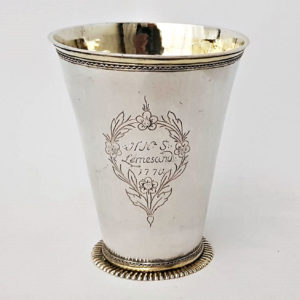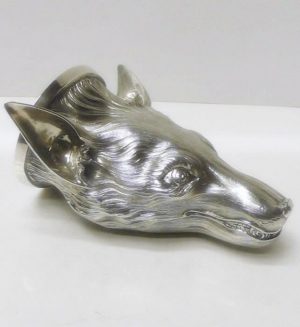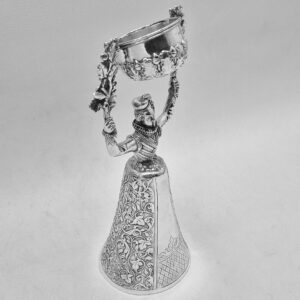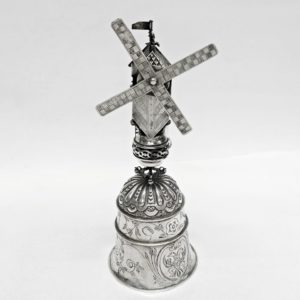Stirrup & Wager Cups
Stirrup & Wager Cups
Browse our collection of specialist and novelty silver drinking vessels. An excellent range of early silver examples for the collector which are ideal for practical use and make a perfect gift.
Silver Stirrup Cups didn’t become popular until the mid 18th century. The name derives from a cup of wine or other alcoholic drink offered to a person on horseback who is about to depart on a journey (with one’s feet in the stirrups). This term is now more associated with the cup used at the traditional fox hunt. The stirrup cup is usually ornamental and often in the form of a fox head.
Silver Wager Cups are often referred to as Windmill Cups or Marriage Cups.
Silver Marriage Cups. These highly collectible double drinking vessels are also known as marriage cups. The idea is to drink the contents of the large cup (the lady’s skirt) without spilling the drink inside the small cup. The bride would drink from the small cup, the groom from the large cup.
Silver Windmill Cups were used as a drinking game. First fill the cup up with a liquor of choice and spin the windmill sails (either by hand or by blowing the horn). The challenge is to drink the contents of the cup before the sails stop. The clock hands on some windmills also revolve with the sails and a penalty would be due depending on the number where the hand (pointer) stopped.”
-


1732
9901 Antique Silver Scandinavian Peg Beaker
Possibly Norwegian or Baltic. A rare piece of parcel gilt silver of tapering straight sided form. With bright gilt banding to the foot, rim, and interior. 18th century. Faintly pricked out at the rim with the year “Anno 1732”. To the front is an engraved cartouche with “HNS Lemesand”. While peg tankards are traditional Scandinavian drinking vessels it is very unusual to find a beaker pegged in this fashion. A charming feature is the way that the pegs have been disguised on the front as flower heads. Contains 520 ml. Weight 220 grams, 7ozs. Height 13cm. Diameter 10.9 (top), 7.3cm (base). Stamped underneath with the maker’s mark “FR” double struck. Scandinavian – possibly Norwegian or Baltic. Circa 1732
-


1773
John Lautier
8086 George III Silver Fox Stirrup Cup
Sold
A beautifully modelled antique sterling silver stirrup cup in the form of a fox head. Fine features and lovely expressive face. Weight 147 grams, 4.7 troy ounces. Length 11.5 cm. Width 10 cm. English silver hallmarks on the rim for London 1773. Maker John Lautier.
-


1829
William Eley
10452 George IV Antique Silver Wager Cup
It’s extremely rare to find an English silver marriage cup at this early date. Modelled as a lady in a long period dress, her outstretched arms hold an acanthus leaf cup that swivels within 2 oak leaf branches. The richly decorated bodice sits over a long skirt which is the inverted drinking cup; deeply chased and hand decorated with matted background and scroll and foliate ornament. Fantastic quality and excellent weight. Weight 624g, 20 troy oz. Height 26cm, 10.2ins. Spread 11.5ins, 4.6ins. Diameter 6cm, 9.6ins. London 1829. Maker probably William Eley II.
-


Circa 1890
9286 Antique Silver Wager Cup
Sold
An antique silver model of a windmill mounted on a wine cup. Hand engraved. Beautifully constructed with multiple moving parts. The windmill house is reached by a staircase with two sculptured figures climbing up, on one side there is a man peeping out of a small window. The revolving windmill sails connect to the clock hands on the other side and both move together. The roof is mounted with a revolving flag, a tiny bird and a sculptured finial. There is a horn which is non-functional. Weight 203 grams, 6.5 troy ounces. Height 22.5 cm. Diameter of cup 8.5 cm. Fully stamped with Dutch silver marks fpr Amsterdam. Circa 1890.